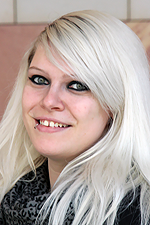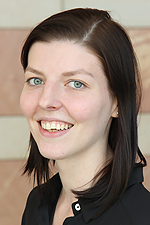 A2.1: Multiple layers of selective photolysis of caging groups
A2.1: Multiple layers of selective photolysis of caging groups
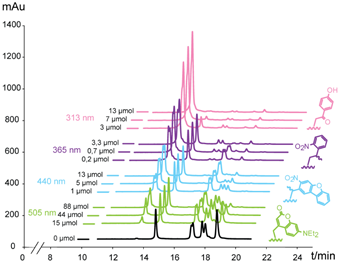
Previous studies in the group of Heckel have shown for the first time that it is indeed possible to realize four layers of sequential uncaging of DNA. However, neither the irradiation time nor the selectivity was optimal yet. Therefore, existing caging group platforms will be optimized by the PhD thesis A2.1 (Matīss Reinfelds). The synthesis (done by A2.1) will be guided by computational predictions from the PhD thesis A1.1 (Jan von Cosel), A1.3 (Konstantin Falahati) and A1.4 (Carsten Hamerla). The performance of the newly developed caging groups will be tested on simple substrates like glutamate or DNA. The aim in this RTG is to establish a feedback loop where synthesis is supported by calculations and the measured photochemical properties of the synthesized compounds can help to fine tune the prediction algorithms. A fine-tuning of the caging group photophysical properties will allow optimization of as many layers of selective uncaging as possible.
Furthermore, Matīss Reinfelds will closely work together with PhD theses A1.1 (Jan von Cosel), A4.1 (Daniela Kern-Michler) and A4.2 (Carsten Neumann) and prepare isotopologues and isotopomers of coumarin photocage for the VIPER experiments (project A4).
Suggested literature:
- "Four Levels of Wavelength-Selective Uncaging for Oligonucleotides", A. Rodrigues-Correia, X. M. M. Weyel, A. Heckel, Org. Lett. 2013, 15, 5500–5503.
- "Wavelength-Selective Uncaging of dA and dC Residues", F. Schäfer, K. B. Joshi, M. A. H. Fichte, T. Mack, J. Wachtveitl, A. Heckel, Org. Lett. 2011, 13, 1450–1453.
 A2.2: Two-photon uncaging of oligonucleotides and peptides
A2.2: Two-photon uncaging of oligonucleotides and peptides
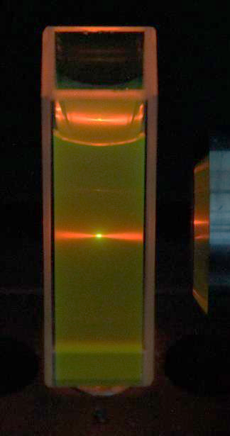 Three-dimensional two-photon uncaging of oligonucleotides is a technique that is yet to be developed fully. The challenges arise first of all in the technical realization of two-photon uncaging of arbitrary areas in a microscope. In this respect all the required devices are functionally assembled in the group of Heckel. The second major challenge is the development of two-photon caging groups. The caging group with the highest action cross-section δ is the EANBP group developed by Goeldner and Specht. However, preliminary experiments have shown that its performance as caging group in nucleic acids is not as good. The third challenge is to find suitable assays to perform 3D two-photon uncaging with oligonucleotides and to quantify the two-photon action cross sections. This is difficult because of the extreme localization of the effect. This PhD student will therefore:
Three-dimensional two-photon uncaging of oligonucleotides is a technique that is yet to be developed fully. The challenges arise first of all in the technical realization of two-photon uncaging of arbitrary areas in a microscope. In this respect all the required devices are functionally assembled in the group of Heckel. The second major challenge is the development of two-photon caging groups. The caging group with the highest action cross-section δ is the EANBP group developed by Goeldner and Specht. However, preliminary experiments have shown that its performance as caging group in nucleic acids is not as good. The third challenge is to find suitable assays to perform 3D two-photon uncaging with oligonucleotides and to quantify the two-photon action cross sections. This is difficult because of the extreme localization of the effect. This PhD student will therefore:
- design optimized two-photon caging groups in collaboration with PhD thesis A1.2.
- synthesize the caging groups with predicted superior properties.
- explore wavelength-selective two-photon uncaging.
- apply these caging groups to caged DNA, RNA and in collaboration with PhD thesis B4.3 to peptides.
- develop assays for the visualization of 3D two-photon uncaging of DNA and RNA
- develop assays for the determination of the two-photon action cross section δ.
Suggested literature:

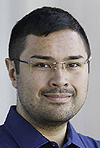 A2.3: Caged fluorophores for super-resolution microscopy and new strategies for the caging of DNA and RNA
A2.3: Caged fluorophores for super-resolution microscopy and new strategies for the caging of DNA and RNA
This PhD student will closely work together with PhD thesis B5.1. The aim is here to provide new possibilities for super-resolution microscopy. To this aim he or she will explore the possibilities to provide fluorophores which are at first caged and hence non-fluorescent but become fluorescent upon uncaging. The better the amplitude of this effect the better the result in the microscopy application.
As second aim this PhD student will explore new ways to destabilize DNA- and RNA duplexes in a close collaboration with PhD thesis B1.3. We will conduct a structure-based approach. In preliminary experiments the Schwalbe and the Heckel groups have investigated the influence of single nucleobase-caged DNA residues both on a global and especially on a local base pair level. They have obtained data on single base pair stabilities with NMR proton exchange experiments and have also obtained NOE-based structural models. Therefore, it has become possible for the first time to really study the effects of configuration and/or steric aspects on the destabilizing capacity of caging groups in DNA. Based on this preliminary work this PhD student – together with PhD thesis B1.3 – will obtain more structures and explore and improve strategies for caging of DNA and RNA. The goal is to maximize the influence of the cage on the structure so that already one cage has a maximal destabilizing effect.
Furthermore, this PhD student will closely work together with PhD theses B1.2 and B2.1 and prepare nucleobase-caged RNA for the investigation of RNA folding pathways.
Suggested literature:
 A2.4: Two-photon uncaging of oligonucleotides and peptides
A2.4: Two-photon uncaging of oligonucleotides and peptides
Full deactivation of DNA- and RNA in the caged state is a major criterion for efficient light regulation scenarios. The achievement of a good ON/OFF-triggering efficiency becomes more and more difficult for longer functional oligonucleotides (> 30 nt) as e.g. for aptamers. A typical strategy would be, to incorporate multiple photolabile protecting groups along the DNA- or RNA-sequence for maximal duplex destabilization. However, long irradiation times or higher irradiation power has to be applied then for complete removal of the cages, by this reducing the spatiotemporal resolution and enhancing the risk for photodamage. New strategies for caging of long functional oligonucleotides are highly desired. The PhD student will investigate methods of oligonucleotide cyclization (e.g. “Click”-chemistry) and their impact on DNA- and RNA duplex stability. The aim is, to have a general approach for caging of long functional oligonucleotides with a minimal number of photolabile modifications.
Also, the PhD candidate will contribute to the development of new photolabile protecting groups, which destabilize the DNA- and RNA more efficiently due to sterically demanding modifications. In this challenge the PhD student will closely work together with PhD theses A2.3 and B1.3.
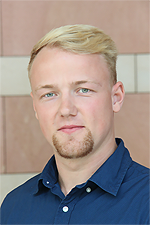 A2.5: Development of new one-photon caging groups
A2.5: Development of new one-photon caging groups
In the first term of CLiC Matiss Reinfelds (A2.1) was able to synthesize isotopologues of caging groups for selective uncaging via the VIPER approach (for an explanation see A4). Daniela Kern-Michler (A4.1) and Carsten Neumann (A4.2) investigated how these coumarin derivatives can be selectively triggered using a combination of irradiation with IR and visible light. Instead of making large changes in the caging groups this VIPER approach makes only minute changes: the isotopologues differ only in the number of neutrons in some of their carbon atoms. However, this can lead to significant shifts of IR bands. The choice of carbon atoms to be modified was guided in theoretical approaches by Jan von Cosel, (A1.1). It was amazing to see the first proofs that this can be a powerful strategy to selective uncaging.
In the second term this principle will now be extended: We will include new uncaging platforms in the VIPER investigation. The question is: since IR bands are rather narrow (in contrast to UV bands), how many different caged compounds can be addressed selectively in the same solution? To this end sophisticated organic synthesis in very small scale with (non-radioactive) isotopes will be necessary - again in close collaboration with theoretical predictions and spectroscopy. Furthermore, we will synthesize VIPER cages with different cargoes and start to study their release on the way to later regulating multiple biological events in cells.
Also in the first term of CLiC Matiss Reinfelds (A2.1) investigated an underdeveloped caging platform based on the meta effect. By Jan von Cosel (A1.1) and Konstantin Falahati (A1.2) possible changes in the photochemical behavior were predicted and guided the synthesis. Iteratively and with a number of unexpected turns, a completely new caging platform was developed which has very interesting photochemical properties.
In the second term this successful concept will be carried on: We will particularly focus on red-shifted caging groups which will be compatible later with uncaging in tissues. Due to the absorbance characteristics of blood, it is important that the new caging groups can operate in a wavelength-window for which very little photochemistry is known, yet. This endeavor will include studying of new photochemical pathways which have received too little attention so far.
 A2.6: Development of new two-photon caging groups
A2.6: Development of new two-photon caging groups
In the first term of CliC Andreas Jakob (A2.2) performed a very systematic search for new two-photon caging groups based on two uncaging platforms. The complicated chromophores were designed in very close contact with Konstantin Falahati (A1.2) and our external advisor Prof. Dr. Andreas Dreuw (Heidelberg). Many different effects were taken into account in the design including different modes of photochemical interaction and degrees of freedom of chromophore subparts. Iteratively, the methods for the prediction of the two-photon cross section of a chromophore were optimized. The newly synthesized chromophores were spectroscopically investigated in detail by Christopher Hammer (A3.2) based on steady-state and ultrafast spectroscopy. This has led to a new understanding of a way to optimize two-photon properties. In collaboration with this project the senior PhD student Manuela Fichte (who acted in CLiC as tutor for this project) was able to realize for the first time orthogonal two-color two-photon uncaging of DNA. The senior PhD student Xenia Weyel (who also acted as tutor) successfully realized two-photon-photocleavable strand breaks in DNA for the regulation of gene expression.
In the second term we will follow this newly established path to new two-photon cages and extend it to a broader systematic study based on several uncaging platforms. This will again be performed in close collaboration with theory and spectroscopy but now especially also with Dr. Stephan Junek (Max-Planck-Institute for Brain Research, Frankfurt). Together with him we want to work on the frontier of real-time two-photon chemistry in living samples using holographic irradiation systems. Therefore, in this project the PhD student will be an integral part of the process starting from the design of new two-photon caging groups, perform their syntheses and accompany their characterization and finally their development and application in high-end microscope systems.
A2.7: Chemo-enzymatic synthesis of photocaged RNA
In a completely new line of investigations this PhD student will study new ways of enzymatic incorporation of caged and photoswitchable residues into DNA and RNA. In the past solid-phase DNA and RNA synthesis has been the way to arrive at the desired oligonucleotides. This has many advantages but also disadvantages. Patrick Seyfried (A2.4) has shown in the first term of CLiC that the number of caged residues in an oligonucleotide can be drastically reduced if it is cyclized using photo-tethers. With the now rather small number of modified residues even for larger oligonucleotides enzymatic methods become interesting and have an entirely different set of advantages and disadvantages. One very important advantage is that this might allow us to now incorporate very interesting caging concepts which did so far not survive the complicated chemical procedures of solid-phase synthesis.
Also this PhD student will continue the collaboration of Patrick Seyfried (A2.4) and Dean Klötzner (A2.3) with György Pintér (B1.4) and the group of Prof. Dr. Gerhard Hummer (Max-Planck-Institute for Biophysics, Frankfurt) in which we are looking for improved ways of incorporating caged into DNA and RNA to make the most of their temporary destabilizing effect. In addition the PhD student of this project will regularly synthesize caged DNA and RNA using the established solid-phase synthesis methods for collaboration partners within CLiC.

